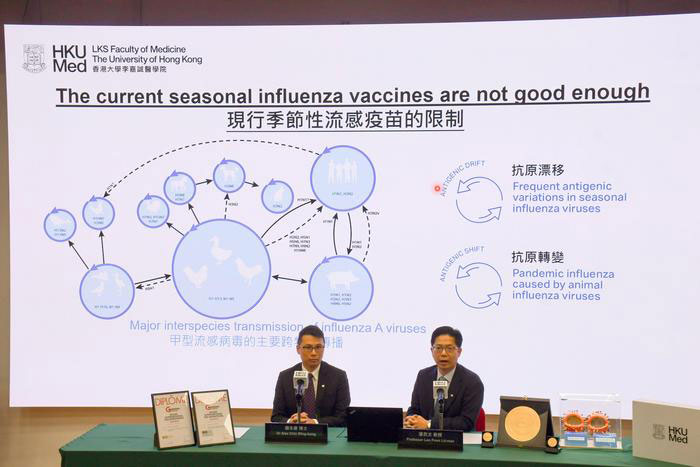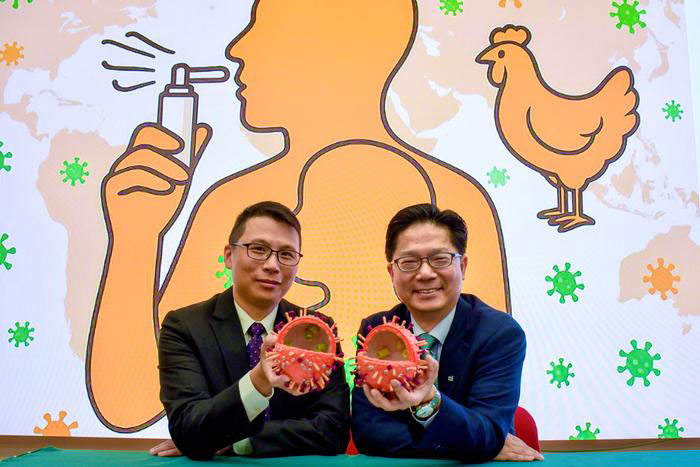Researchers at the School of Public Health, LKS Faculty of Medicine, University of Hong Kong (HKUMed), in collaboration with the Centre for Immunology & Infection (C2i), have developed new needle-free, live-attenuated influenza vaccine (LAIV) candidates that show potential for broader protection against both human and avian influenza subtypes. These developments represent a step forward in the ongoing effort to create more effective and versatile influenza vaccines. The innovations have received international recognition, including multiple patents and awards at the 50th International Exhibition of Inventions Geneva 2025.
Limitations of Current Influenza Vaccines
Seasonal influenza continues to pose a significant burden on global healthcare systems. While annual vaccination remains the primary preventive strategy, current vaccines are limited by their strain specificity and the need for frequent reformulation. Their effectiveness can be compromised if circulating strains diverge from those predicted, and they provide limited or no protection against zoonotic influenza viruses, including avian subtypes. In response to these challenges, the World Health Organization has emphasized the need for next-generation, broadly protective influenza vaccines.
Two Scientific Approaches to LAIV Development
The HKUMed team employed two distinct strategies to engineer next-generation LAIVs.
Alpha-Gal Epitope-Based Immunopotentiation
The first approach involved incorporating a human α-1,3-galactosyltransferase gene into a human influenza virus genome. This genetic modification induces the expression of α-Gal epitopes on infected host cells, which are then targeted by naturally occurring anti-α-Gal antibodies in humans. The interaction is expected to enhance immune responses through mechanisms such as antibody-dependent cellular cytotoxicity, phagocytosis, and opsonization.
In mouse models, the vaccine was shown to be attenuated and non-pathogenic, while eliciting both innate and adaptive immune responses. Immunized mice demonstrated protection against a range of influenza A virus subtypes, including seasonal H1N1 and H3N2, as well as avian H5N1.
Codon Reprogramming for Viral Attenuation
The second approach utilized codon deoptimization, where silent mutations were introduced to shift the virus’s codon usage from a human to an avian pattern. This resulted in attenuation in mammalian hosts while retaining replication efficiency in chicken eggs—a critical factor for scalability using current manufacturing infrastructure.
The resulting LAIV candidates maintained wildtype-like protein expression and induced immune responses against both seasonal and avian influenza viruses. In vitro and in vivo assessments confirmed the attenuation and immunogenicity of these vaccine strains, which included multiple backbones such as H1N1 and H3N2. The candidates provided protection in mice against H1N1, H3N2, H5N1, and H7N9.

Potential Advantages and Considerations
Live-attenuated vaccines delivered intranasally have been shown to stimulate mucosal immunity along the respiratory tract, which may offer enhanced protection at the site of viral entry. Additionally, needle-free administration may improve vaccine acceptance, particularly in younger populations. However, further studies will be needed to evaluate the durability and breadth of protection in humans.
Professor Leo Poon Lit-man, Chair Professor of Public Health Virology at HKUMed, noted that while these LAIV platforms are still in the preclinical stage, they offer a potentially valuable tool for improving influenza preparedness, including protection against novel and zoonotic strains.
Next Steps in Research and Development
The research team intends to further advance these LAIV candidates through collaborations facilitated by the Hong Kong Jockey Club Global Health Institute (HKJCGHI) and the International Vaccine Institute (IVI). Upcoming work will focus on studies that adhere to Good Laboratory Practice (GLP) standards, with the goal of supporting future clinical evaluation.
SOURCES AND FURTHER READING:


